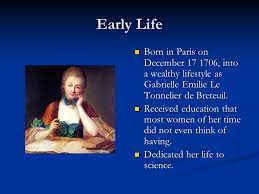The most important achievement of milie du Chtelet was her work as a philosopher, translator and astronomer. Her works include translation of the fable of the bees, a prize essay on fire and her own philosophical writings have been recognized by the Academie des Sciences.
Translation of The Fable of the Bees
Du Chatelet’s contributions to the Enlightenment made her one of the most prolific writers of the era. Her works include the translations of The Fable of the Bees and Institutions de physique. Several projects are under way to edit her writings in France.
In addition to her translations, she wrote numerous other works, including a number of philosophical treatises. She is known as the expositor of Newton. This is due to her renowned work, which is the only French-language translation of the mathematician’s work.
As a result, her work was not recognized by the Academie Royale des Sciences, despite the fact that she was not a member of the institution. Nonetheless, du Chatelet was credited by Diderot and D’Alembert in an entry on Newtonianism.
During her lifetime, she worked feverishly to finish her translation of the Principia. Though it was not a complete work, it is considered to be her greatest achievement.
After her death, her translation was published posthumously. It became the standard in French for several decades, and remains the only French-language translation of the mathematical work.
https://www.youtube.com/watch?v=QZNhtL6Qu6g
Prize essay on fire by the Academie
There is a prize for the best essay about fire written during the 19th century. One of three winners is the Marquise Du Chatelet. Its main competitor was the aforementioned Euler. Nevertheless, it was only natural that Du Chatelet would try to beat out the competition by writing an essay of her own. The good news is that she did it in style. Notably, Du Chatelet had her work cut out for her as she had to juggle two separate careers. Her achievements as a mathematician and a polymath were not without their fair share of bumps and bruises.
One of her many accomplishments was the translation of Isaac Newton’s Philosophiae Naturalis Principia Mathematica, which was arguably her magnum opus, and is a worthy contender in her long list of accolades. Of course, she also churned out some nifty philosophical works of her own, including the aforementioned fabled elixir. Aside from the obvious task of educating her illustrious patrons, Du Chatelet was a prolific letter writer and a savvy entrepreneur in the business of her own business.
Her own philosophical works have been recognized
Emilie du Chatelet (1714-1749) was a French philosopher who was involved in numerous important philosophical disputes in the 1740s. She wrote several works, including Institutions de physique and The Foundations of Physics. Her works were also reviewed in the Journal des scavans.
During her time in France, Du Chatelet was tutored by natural philosopher Pierre Louise Maupertuis. After his recommendation, Du Chatelet’s tutor, Samuel Konig, took over. Later, Clairaut also became her tutor.
In 1738, Du Chatelet wrote an anonymous dissertation on fire. This work focused on the physical properties of fire. It was published in an anonymous edition by the Academie Royale des Sciences.
After this, she published several essays, including a commentary on the Fable of the Bees by Bernard Mandeville. She also translated the Principia of Isaac Newton. Eventually, she wrote the essay on nature and propagation of fire. It was submitted to the Academy of Sciences competition in 1737.
However, her essay was not awarded the prize. It is now considered one of the most influential philosophical texts of the Enlightenment.
She was a muse of astronomy
Emilie du Chatelet was a major figure in nineteenth century natural philosophy. She wrote several books and was a well-known translator of Isaac Newton’s Philosophiae Naturalis Principia Mathematica. Her translation of the text is still a standard in French, and she also co-wrote commentary on the work with mathematician Alexis Clairaut.
Du Chatelet was involved in numerous important philosophical disputes in the 1740s. One of the most significant was the vis viva debate, which focused on the proper methods for measuring the force of a body. It began with Leibniz’s criticisms of Cartesian views of the human body in 1686.
During this time, Du Chatelet maintained a network of contacts with influential individuals throughout Europe. She was especially interested in the development of natural philosophy. By 1747, she had published multiple treatises, and was already a well-established intellectual.
As a member of Frederick the Great’s Prussian Royal Academy of Sciences in Berlin, Du Chatelet was exposed to the ideas of Leibniz. She was also a tutor to Samuel Koenig, an eminent mathematician.







